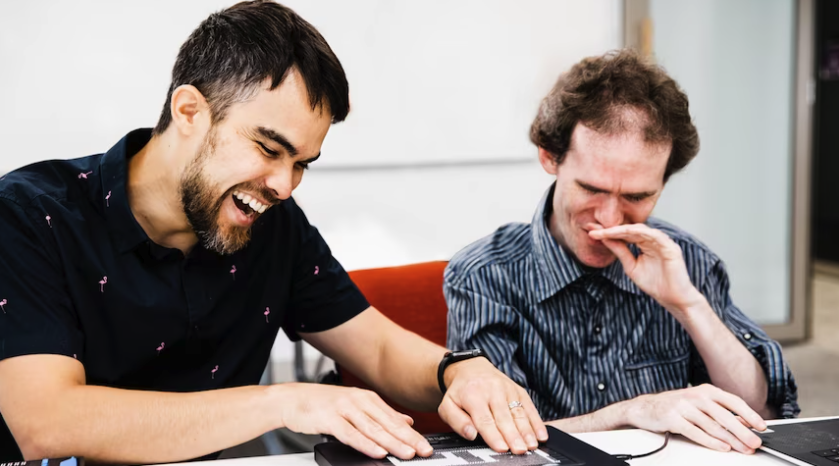PR/IR
News
News
News
- Date
- 2023.06.05 10:00
How friendship between NVDA founders Mick Curran and Jamie Teh is changing lives for thousands of blind people
Imagine what an airport terminal would be like for a blind person. Unable to see the signs telling you where to go — a great cavernous space full of rushing strangers.
"There's just so much noise from all the travellers and suitcases around you echoing off the floor and walls," says Mick Curran, who has been completely blind since he was 15. "Airports can be pretty overwhelming."
But Mick has had to get used to airports. He and his childhood friend Jamie Teh, who is also blind, are rock stars of the software world and they get around.
"I have learned to roll with it," Jamie tells Australian Story. "Take it as it comes."
Loading...
Mick and Jamie's disabilities have not been a barrier to success.
The pair created screen-reading software called NVDA (Non-Visual Desktop Access) when they were fresh out of university. Seventeen years later, it's now used by 275,000 people in 175 countries and has been translated into 50 languages.
"It is the only screen reader in the world that's made by blind people for blind people," says disability advocate Ben Clare, "and opened doors for people with vision impairment".
Loading...
NVDA had the potential to make them very rich but from the outset, they were determined that the software would be free and open source.
Both Mick and Jamie knew from personal experience how expensive it can be for visually impaired people to access the software to independently use a computer.
Commercial screen-reading software can cost upwards of $1,000. "Why should a blind person have to pay an extra thousand dollars in order to use a computer to the same extent as a sighted person?" Mick says.
"Blind and vision-impaired people shouldn't have to be superheroes or have super wealthy families to benefit from the same education and opportunities as everyone else."
Jamie and Mick strongly believe everyone should be able to use a computer.(Australian Story: Marc Smith)
'I've got bad news': Mick loses his vision
Mick's cornea transplant at age four was life-changing.(Supplied: Mick Curran)
Mick Curran was born with only one eye and his oesophagus wasn't joined in the middle.
Before he was five, he had seven operations on his stomach and chest. He had some sight, but it was blurry.
When he was four, he became the youngest child in Victoria to have a corneal transplant. It improved his sight dramatically, allowing him to read very large print. But as he got older, his sight began to deteriorate, and when he was 15, doctors suggested another corneal transplant.
Mick (pictured before his operation) became completely blind at age 15.(Supplied: Mick Curran)
"They were honest and told me that there was probably a 70 per cent chance of success," Mick says. "As a teenage boy, I heard 100 per cent. I did not process that at all as a risk. I think in my mind I was thinking perhaps I might even be almost fully sighted."
But the operation didn't go to plan.
"They came out quite quickly," Mick's mother Debbie recalls, "And just said, 'I'm very, very sorry. We've got bad news, as soon as we operated, his retina's haemorrhaged. There's just nothing we can do'.
"The first thing Michael said to me was, 'Did they put a lens in?' And I said, 'No, you've got no vision. That's it'. And he just was silent."
'I was three months old when I had my first eye removed'
Unlike Mick, Jamie was completely blind by the time he was six months old. Not long after birth, he was diagnosed with tumours in both eyes and his parents had to make the agonising decision whether to have his eyes removed or risk radiation treatment. "It had to be his eyes because I wanted him alive no matter what," says his mother, Sharon.
Jamie became fascinated with computers and programming when he was nine.(Supplied: Jamie Teh)
"I was only three months old when I had my first eye removed, and then my second eye was removed at six months," Jamie explains. "I have two artificial eyes. So, both my eyes are removable."
Jamie showed an interest in computers from an early age. When he was in year four at primary school, his father bought a second-hand computer and Jamie said he wanted to learn basic programming.
"I bought an old book for programming," Jamie's father Terry says, "And over a period of a week or so I read to him the whole book. So there were 100 questions in the book. Jaime got three wrong out of the hundred. I thought, 'God this guy is really, really so smart'."
Music, mates and a big dream
When Mick lost his sight after the unsuccessful operation, he became despondent. "I was very, very moody," he says. "I guess I felt just completely numb and disconnected."
Mick (pictured) and Jamie met at a music camp when they were kids.(Supplied: Mick Curran)
But he had always been interested in technology and music and he found solace in those interests. "I think what brought me out of my depression was identifying and throwing myself into skills that I already had and enjoyed doing."
The following year he went to a braille music camp that he had attended when he was 10. Back then he met Jamie, who was a year younger, and they hit it off immediately. Once again, Jamie was at the camp and the pair immediately picked up their friendship. "It was like we'd never, never left each other," Mick says. "I think I was drawn to Jamie because he was very much like me in a lot of ways, he was very intellectual."
It was around this time that they began discussing how good it would be if there was a free screen reader that all blind people could use. "We both had a really big interest and passion for this emerging open source and free software movement, we talked about that quite a lot at music camp."
Mick and Amy meet through their involvement in the Victorian blindness advocacy community. (Supplied: Mick Curran)
Duo 'grinds away' at a life-changing idea
After school, both Mick and Jamie went on to study computing at university. They both married — Jamie to Jennifer and Mick to Amy — and when Mick moved from Victoria to Queensland, the couples ended up living five minutes away from each other.
Their idea of creating free screen-reading software for the visually impaired kept ticking over. Mick knew that 60 per cent of blind people were unemployed, "and that's partly to do with lack of technology". Eventually, he dropped out of university to try to turn the idea into a reality.
"I could see the potential for people around the world who were far less fortunate [to] not just access … technology but to change their lives, to get an education, to get jobs, to be able to socialise, to be independent and reach their potential."
Mick and Jamie in the early days of NVDA.(Supplied: Jamie Teh)
By this time, Jamie had a computer programming job and would work on the NVDA project during lunch breaks. Before long, Mick asked him to work on the project full-time, because "it would actually get it there a lot faster."
Risk-averse, Jamie had doubts, until his wife told him that if he didn't take the opportunity, "you're going to regret it for the rest of your life".
Mick says keeping NVDA open-source means the general public can contribute to the code and even translate into their language.(Australian Story)
For a long time, Jamie says, "it was just the two of us, just grinding away. We knew it was possible and it was going to take a long time".
They got early funding from the Mozilla Foundation, but it was only when they started receiving emails from people overseas wanting to translate the software and use it in their own countries that they realised how important it was going to be. More funding began to come in and the pair found themselves increasingly feted.
While Jamie once worked full-time with NVDA, he now contributes where he can between his regular job as a programmer.(Australian Story: Kate Wilson)
'They are an inspiration for us who are blind'
In January, Mick and Jamie visited Samoa to see how their software was being used to run the braille unit at the Samoa Blind Persons' Association.
"Everybody at the Samoa Blind Persons' Association knows the story of Jamie and Mick," says Ari Hazelman, who has been blind since birth. "The fact that they themselves were blind is an inspiration for us who are blind so we can strive more to improve our communities."
Ari Hazelman from the Samoa Blind Persons' Association delivers braille school materials to teenager Harry Harim.(Australian Story: Marc Smith)
Disability has only recently been included in the census in this Pacific Island nation, so there aren't accurate figures on how many in Samoa are vision-impaired.
"Some people feel very vulnerable or very reluctant to call themselves a person with disabilities," says Faatino Utumapu, Ari Hazelman's colleague.
"They are often considered as a burden for the family, considering that the responsibility to care for family members rests with the families themselves with minimum support by the government."
Ari Hazelman calls Mick and Jamie an "inspiration" to their community.(Australian Story: Marc Smith)
Mick and Jamie say they know the impact of their work, but rarely get to see it in action.
The Samoa Blind Persons' Association uses NVDA to edit and translate student materials, restaurant menus, as well as government and United Nations documents into braille.
The association provides backup and support for young people with vision impairments to remain in education, such as teenager Harry Harim, who dropped out of school last year for personal reasons.
Harry has now returned to school, where braille materials are key to his learning.(Australian Story: Marc Smith)
Ari home-delivers Harry's schoolwork supplied by his teacher and translated into braille by the association, so Harry doesn't fall behind.
"When I lost my vision as a 15-year-old, I really locked myself away from the world. So any help that people can provide teenagers like Harry in regard to making school that little bit easier is a great thing," Mick tells Australian Story.
Harry has recently returned to the classroom.
The Samoa Blind Persons' Association uses NVDA to translate documents and print them into braille.(Australian Story: Marc Smith)
Pair will 'never ever' take money for software
Over the years, many people — including friends and family — have pointed out the obvious opportunity that exists for Mick and Jamie to make money from the NVDA. But they remain adamant that it should be free.
"The reason we started NVDA and the reason we continue with NVDA is purely for the fact that there needs to be a free, open-source screen reader for blind people around the world," Mick says. "And we are never, ever going to sacrifice that no matter how much people ask or how much people offer us."
Jamie has now stepped back from NVDA but remains on the board and still contributes code along with the open-source community. Mick continues to work full-time on the software.
Jamie and Mick are sought after for their expertise in screen reader software.(Australian Story: Kate Wilson)
Mick and Jamie test out a prototype braille graphic display device by Korean company Dot Inc.(Australian Story: Kate Wilson)
Ultimately, they see NVDA as an investment in the future.
"Everyone in the world has a right and responsibility to contribute what they can to make the world a better place. But if they aren't given the tools that help empower them then, we don't benefit from the great things they could contribute," Mick says.
"There are countless examples throughout history of people with disabilities that have done amazing things. And if they hadn't been enabled to do those things, we would have missed out as a society."


 Prev
Prev
 Next
Next









